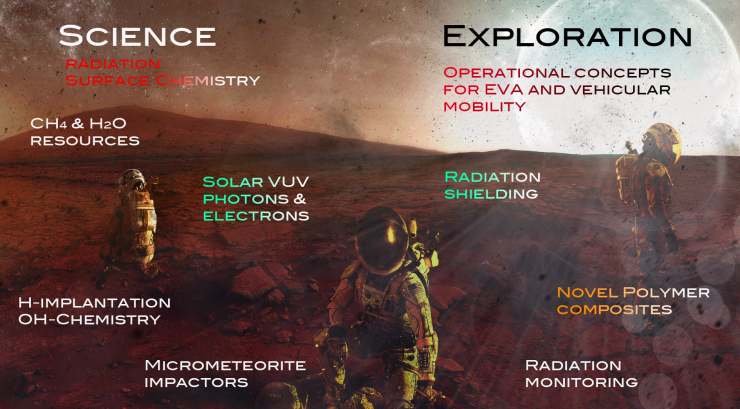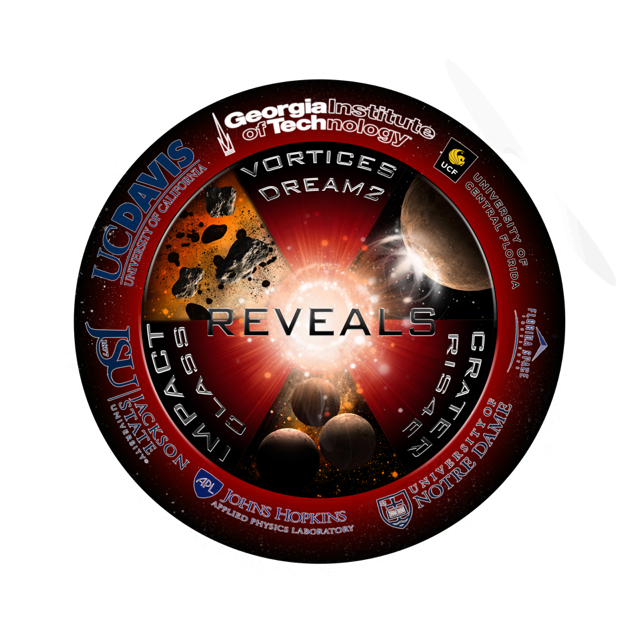
The year is 2030, and U.S. astronauts are living and working on the Martian moon Phobos. Their underground habitats, equipment, and spacesuits are protected from radiation and micrometeorites, thanks to an innovative mix of sturdy polymers and nanomaterials. In fact, a special coating allows portions of the suits to double as real-time radiation detectors.
Meanwhile, the solar wind streaming onto Phobos’ surface holds the promise of life for those astronauts.
“Does the solar wind, which is mostly protons and electrons, produce water when it interacts with the regolith?” asks Thomas Orlando, professor in the School of Chemistry and Biochemistry. “Astronauts want water. They need water. They’re not going to carry jugs of distilled water. Is there enough water there for on-site use or, to go even further, to transform into fuel?”
Those are questions that Orlando and a large multidisciplinary research team, with specialists from across the U.S., Germany, and Italy, will soon try to answer, thanks to NASA funding.
NASA announced on March 17 that Orlando’s team– Radiation Effect on Volatiles and Exploration of Asteroids and Lunar Surfaces (REVEALS) – is one of four chosen by the space agency for inclusion in SSERVI – the Solar System Exploration Research Virtual Institute. NASA created SSERVI to work with scientific institutions around the world to learn more about the lunar surface, near-Earth asteroids, and the Martian moons Phobos and Deimos. REVEALS has requested a $5.5 million budget over five years.
A Global Team
Within Georgia Tech, Orlando’s team include Phillip First and Zhigang Jiang in the School of Physics, Peter Loutzenhiser in the George W. Woodruff School of Mechanical Engineering, Carol Paty and James Wray in the School of Earth and Atmospheric Sciences, John Reynolds
 and Joseph Perry in the School of Chemistry and Biochemistry, and Jud Ready in the Georgia Tech Research Institute.
and Joseph Perry in the School of Chemistry and Biochemistry, and Jud Ready in the Georgia Tech Research Institute.

Other institutions working with Georgia Tech on REVEALS are the University of California, Davis; Jackson State University; Johns Hopkins University Applied Physics Lab; University of Notre Dame; Florida Space Institute; and the University of Central Florida (UCF).
International collaborators include the University of Stuttgart Institute of Space Systems, the Istituto Nazionale di Astrofisica Catania Astrophysical Observatory in Italy, and the Sapienza University of Rome.
All the collaborations are important because they provide the correct mix of expertise, Orlando says. As an example, the leadership team involves a former astronaut, Stephen Robinson (UC-Davis), and a flight physician, Esther Beltran (UCF).
A Giant Leap for Georgia Tech Space Research
REVEALS is an important step in the well-established relationship between Georgia Tech and NASA. It also validates Tech’s interdisciplinary approach in solving big-science problems, Orlando says.
A veteran of applying for NASA requests for proposals, Orlando says the REVEALS win is his biggest yet, because of its interdisciplinary approach. “It’s probably the most important because it links many entities on campus that haven’t been linked before,” he says. For example, Orlando will be working with the Georgia Tech’s aerospace engineers some who have launched experiments in shoebox-sized satellites, called CubeSats.
“Then it links us across the country, and it links us to groups in Germany and Italy, so we have this pretty strong team that’s global.” REVEALS is a worldwide project, Orlando says, “but it’s based at Georgia Tech, and we’ll manage the budget and science directions.”
REVEALS also spotlights the role of the Institute’s Center for Space Technology and Research (C-STAR). Its goal is to bring more space science enterprise projects to Georgia and the Southeast. “C-STAR is a very strong entity on campus,” Orlando says. “REVEALS now gives some immediate higher visibility to CSTAR nationally and internationally.” Currently, Orlando also serves as the Director of CSTAR.
What REVEALS Hopes to Reveal
“If you want to go into space and understand what you find there,” says School of Chemistry and Biochemistry Chair M.G. Finn, “you have to understand the chemistry under your feet, no matter what world you are standing on!”
REVEALS has two research themes: understanding the interaction of radiation and micrometeorites with the surfaces of airless bodies like Earth’s moon and Mars’ moons and developing and testing new materials for improved safety and health during human exploration.
From those starting points, the REVEALS team hopes to answer these questions:
- What are the primary mechanisms, such as solar wind, that produce, transport, or destroy volatiles – substances that readily vaporize, like water and hydrogen – on airless celestial bodies?
- Does micrometeorite bombardment contribute to the evolution of volatiles?
- Is there an operationally useful inventory of resources on these airless bodies that can support human exploration? Could water and other elements be mined somehow on site?
- Can nanocomposite materials reduce the risks associated with radiation on the lunar surface or on Mars’ moons so that astronauts can spend more time exploring?
- Can the novel properties of new materials be exploited to develop real-time radiation monitors?
- Can new polymer-based flexible materials be incorporated into spacesuits and/or vehicles to enhance human safety during surface operations?
Radiation Assault and Better Spacesuits Through Chemistry
To help answer those questions, the REVEALS team will conduct experiments that simulate what happens when small dust grains and micrometeorites smash into regolith, the top layer of soil and broken rocks found on Earth’s moon and near-Earth asteroids.
Previous experiments at other institutions have correctly simulated momentum and impact, but not the chemistry, Orlando says. “We are setting up a laser to accelerate actual dust grains to the right velocities before shooting them into regolith-like materials,” Orlando explains. “There is nobody in the world doing this. Even NASA says that this experiment could change the landscape.”
Another point NASA liked about the REVEALS project, Orlando says, is the goal of providing astronauts with radiation detectors. Astronauts currently have no way to find out in real-time how much radiation they’re receiving in airless environments. REVEALS wants to develop a passive device or a way to coat future spacesuits with materials that can also read radiation charge. “So the material or suit itself is not only hardened against radiation, but it’s also a real-time monitor of the charges produced by the impacting radiation,” Orlando says. “We want to try to spin this capability into a protective coating, not just for a space suit, but also a habitat.” Some of the work toward radiation detectors has evolved from projects that Orlando and First have been involved in for more than a decade dealing with graphene.
“REVEALS will further establish Georgia Tech, the College of Sciences, and the Southeast region of the U.S. as leaders in this most human of scientific endeavors,” Finn says.
- Renay San Miguel, GA Tech News Center
